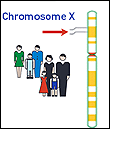|
 Previous Event | Next Event Previous Event | Next Event 
1986: First Time Gene Positionally Cloned
 Positional cloning is the method of finding a gene without any knowledge of the protein it encodes. The first human disease gene identified by positional cloning was one for chronic granulomatous disease. Positional cloning is the method of finding a gene without any knowledge of the protein it encodes. The first human disease gene identified by positional cloning was one for chronic granulomatous disease.
Perturbations in more than one gene can cause the CGD phenotype, characterized by the presence of inflamed lesions containing phagocytic immune cells. A group from Boston Children's Hospital isolated the CGD gene on Xp21. The genes for Duchenne muscular dystrophy and retinoblastoma followed quickly.
More Information
References:
Royer-Pokora, B., Kunkesl L.M., Monacos A.P., Goff, S.C., Newburger, P.E., Baehner, R.L., Cole, F.S., Curnutte, J.T., Orkin, S.H. Cloning the gene for an inherited human disorder--chronic granulomatous disease — on the basis of its chromosomal location. Nature, 322(6074):32-8. 1986. [PubMed]
Abstract: The gene that is abnormal in the X-linked form of the phagocytic disorder chronic granulomatous disease has been cloned without reference to a specific protein by relying on its chromosomal map position. The transcript of the gene is expressed in the phagocytic lineage of haematopoietic cells and is absent or structurally abnormal in four patients with the disorder. The nucleotide sequence of complementary DNA clones predicts a polypeptide of at least 468 amino acids with no homology to proteins described previously.
Robertson, M. The proper study of mankind. Nature, 322(6074):11. 1986. [PubMed]
Lewin, R. First success with reverse genetics. Science, 233(4760):159-60. 1986 [PubMed]
 Previous Event | Next Event Previous Event | Next Event 
Last Reviewed: April 17, 2008
|

